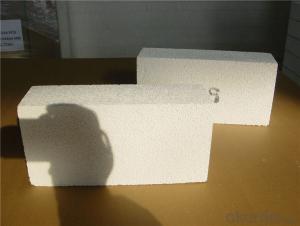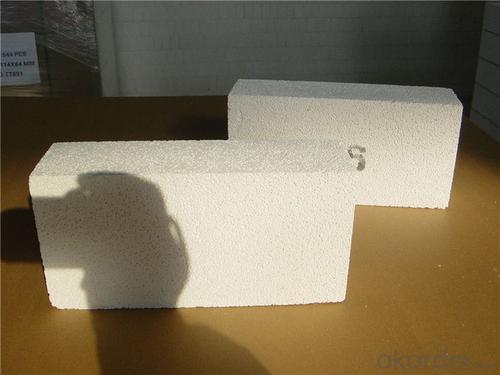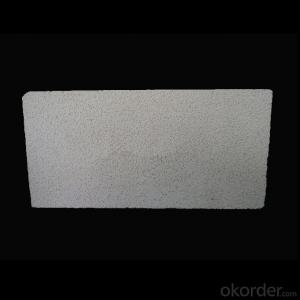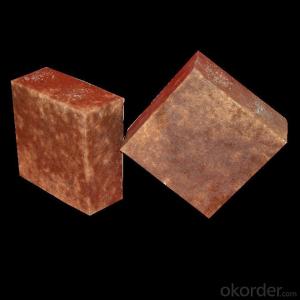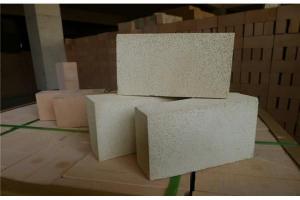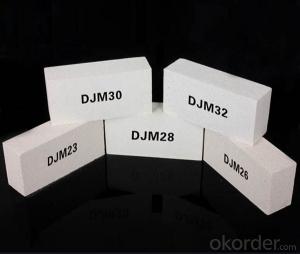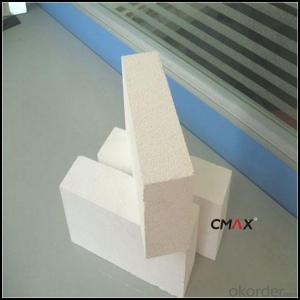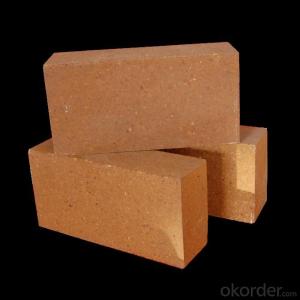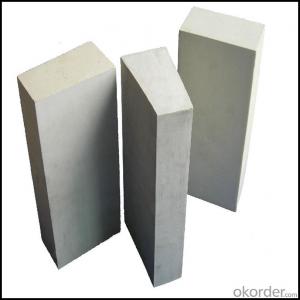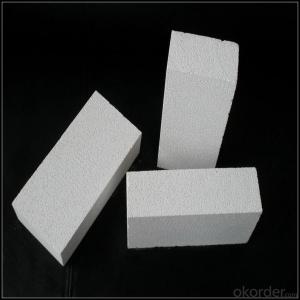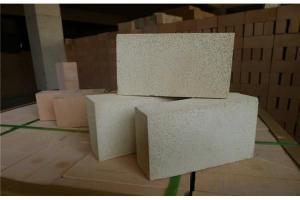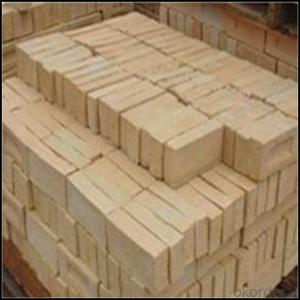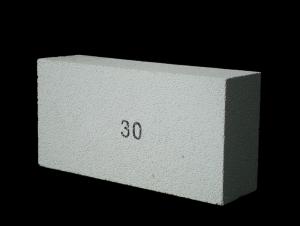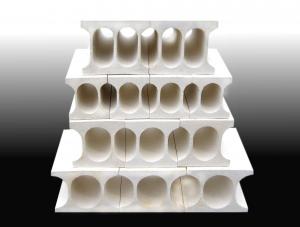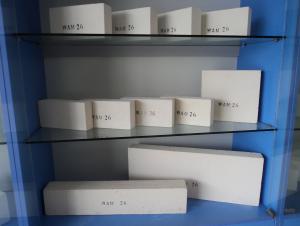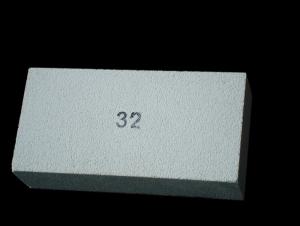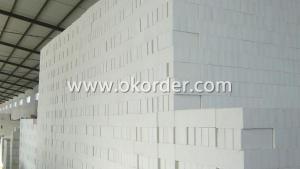Insulating Fire Brick with Excellent Insulating Effect - Common Size for Heat Treatment Furnace
- Loading Port:
- Tianjin
- Payment Terms:
- TT OR LC
- Min Order Qty:
- 10 m.t.
- Supply Capability:
- 10000 m.t./month
OKorder Service Pledge
OKorder Financial Service
You Might Also Like
CNBM conforms strictly to the requirements of ISO 9000 quality control system during the production. MSDS is also available if you want. The thermal insulation fire clay brick meet with the requirements of ASTM & JIS standards. So please stay cool with our quality.
Application
Insulating Fire Brick are used for the lining of converter, alternating current arc furnace, direct Current arc furnace and the ladle slag line, etc.
Insulating Fire Brick Technical index
Brand Quality | JM23 | JM26 | JM28 | JM30 | JM32 | |
Bulk Density (g/cm3) | 0.52 | 0.78 | 0.88 | 1.03 | 1.25 | |
1.2 | 1.6 | 2.1 | 2.5 | 3.5 | ||
Modulus of Rupture (Mpa) | 0.9 | 1.4 | 1.6 | 2.1 | 2.1 | |
-0.5 | 1400℃ -0.4 | 1510℃ -0.5 | 1620℃ -0.9 | 1730℃ -0.9 | ||
Thermal Expansion 1100℃(%) |
0.5 |
0.7 |
0.8 |
0.9 |
1.1 | |
Thermal conductivity(W/m.k)
| 400℃ | 0.14 | 0.27 | 0.32 | 0.41 | 0.49 |
600℃ | 0.16 | 0.29 | 0.34 | 0.43 | 0.50 | |
800℃ | 0.18 | 0.31 | 0.36 | 0.44 | 0.51 | |
1000℃ | 0.20 | 0.33 | 0.38 | 0.45 | 0.53 | |
Al2O3 | 37 | 58 | 67 | 73 | 77 | |
Fe2O3 | 0.7 | 0.7 | 0.6 | 0.5 | 0.4 | |
Equipment
1 unit of Ceramic Abrasive (SG Abrasive) pilot production line
2 units of Compact grain Abrasive pilot production lines
1 unit of high-end coated abrasives (abrasive cloth) production line
2 units of Boron Carbide production lines
3 large flexible crushing and sieving lines for grit production lines
2 units of 2000KVA furnaces for Boron Carbide fusion
6 units of 5000KVA-10000KVA dumping type electric arc furnaces for Brown Fused Alumina fusion
Company Advantage
(1)Long Insulating Fire Brick manufacture history: 25 years manufacturer
(2)Advanced equipment
(3)Diversification of production standards: ISO ANSI FEPA JIS ASTM
(4)Flexible payment: T/T L/C D/P D/A
(5)Professional marketing team and after-sale service
(6)Free sample
FAQs
Q1 |
What’s the transport method? |
A1 | FCL delivery goods with wooden pallet or wooden case by sea; If LCL delivery, must with wooden case; Sometimes need open top, flat rack or bulk cargo. |
Q2 |
What’s the required payment term? |
A2 | Generally 30% TT as the prepayment, 70% TT before delivery. If need, 100% Irrevocable Letter of Credit or negotiation. |
Q3 |
Which country are our products exported to? |
A3 | Apart from entire Chinese market, the US, Russia, Japan, Korea, Australia and some Southeast Asian Nations. |
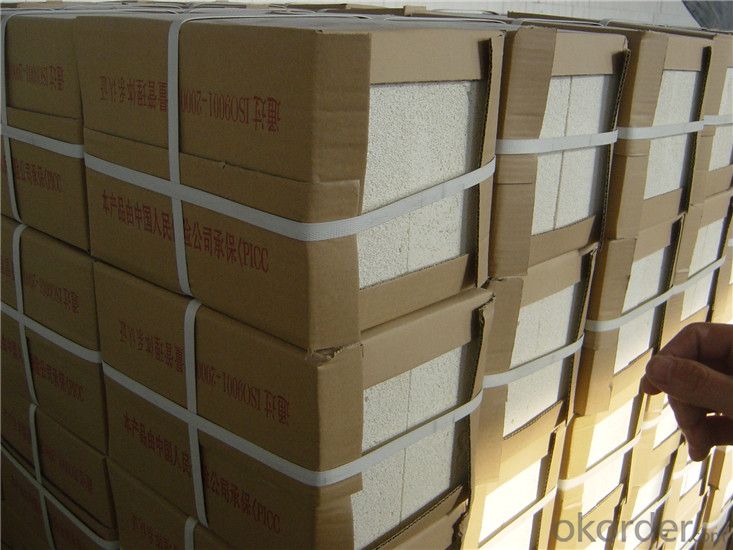
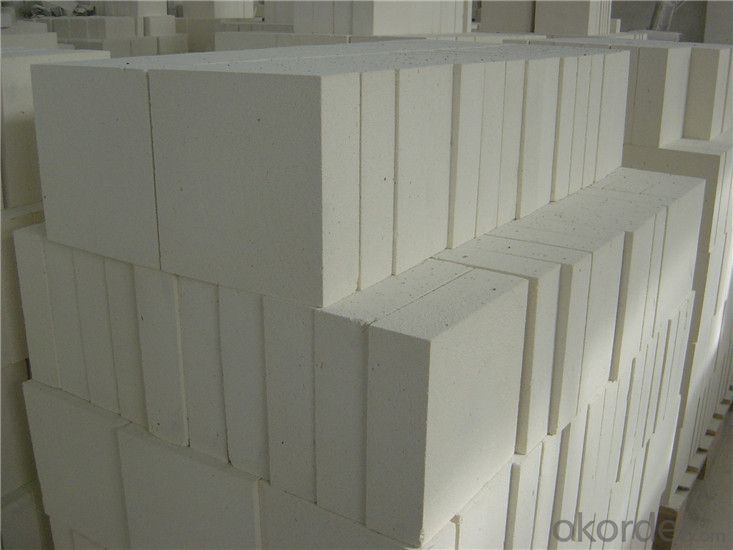
- Q: Are insulating fire bricks resistant to fluorine gas?
- Yes, insulating fire bricks are generally resistant to fluorine gas due to their refractory properties and ability to withstand high temperatures and chemical corrosion.
- Q: Can insulating fire bricks be used in the construction of high-temperature reactors?
- Indeed, high-temperature reactors can incorporate insulating fire bricks in their construction. These bricks are explicitly engineered to endure elevated temperatures, rendering them apt for deployment in high-temperature settings like reactors. Their exceptional thermal insulation qualities contribute to minimizing heat loss and upholding the desired temperature within the reactor. Moreover, insulating fire bricks boast remarkable refractoriness, enabling them to endure intense heat without substantial distortion or harm. Hence, they represent an optimal selection for the construction of high-temperature reactors, wherein maintaining a steady and regulated temperature is vital for the reactor's effective operation.
- Q: Can insulating fire bricks be used in the construction of radiant tubes?
- Yes, insulating fire bricks can be used in the construction of radiant tubes. Insulating fire bricks are specially designed to provide excellent thermal insulation, making them ideal for applications where heat retention is important. Radiant tubes are used in high-temperature environments, such as furnaces and kilns, where they are exposed to extreme heat. Insulating fire bricks can withstand these high temperatures and help to minimize heat loss, resulting in improved energy efficiency. Additionally, the insulating properties of these bricks can also help to protect the radiant tubes from thermal shock and prolong their lifespan. Overall, using insulating fire bricks in the construction of radiant tubes can enhance their performance and durability.
- Q: Are insulating fire bricks resistant to acid or alkali attacks?
- Insulating fire bricks are generally resistant to acid attacks, as they are made from materials such as alumina and silica, which have high resistance to acids. However, their resistance to alkali attacks may vary depending on the specific composition of the bricks and the concentration of the alkali solution. Some insulating fire bricks may exhibit good resistance to alkali attacks, while others may be more susceptible to degradation in the presence of alkali substances. It is important to consult the manufacturer or refer to the specific product specifications to determine the level of resistance to acid or alkali attacks for a particular type of insulating fire brick.
- Q: Can insulating fire bricks be used for insulation in furnaces?
- Indeed, insulation in furnaces can be achieved by utilizing insulating fire bricks. Constructed from lightweight materials like clay and minerals, these bricks possess exceptional thermal insulation characteristics. Specifically designed to endure intense temperatures, they are well-suited for furnace applications. By impeding heat leakage from the furnace, these bricks aid in diminishing heat loss and heightening energy efficiency. Furthermore, insulating fire bricks serve to safeguard the furnace's external structure from excessive heat, thereby prolonging its lifespan. All in all, when it comes to insulation in furnaces, insulating fire bricks are a dependable and efficient option.
- Q: Are insulating fire bricks resistant to sulfur dioxide?
- In general, insulating fire bricks do not possess resistance against sulfur dioxide. This highly corrosive gas can undergo reactions with the components of insulating fire bricks, resulting in their deterioration and diminished efficiency. Therefore, it is crucial to utilize refractory materials that are specifically engineered to endure exposure to sulfur dioxide, whenever such a requirement exists for the intended application.
- Q: Do insulating fire bricks require special storage conditions?
- Special storage conditions are not necessarily required for insulating fire bricks, but it is recommended to keep them in a well-ventilated, dry, and cool area. These bricks are made from lightweight materials that are designed to endure high temperatures and provide heat insulation. However, excessive moisture or exposure to extreme temperatures can potentially impact their performance and durability. It is advisable to shield the bricks from direct sunlight or rain, as extended exposure to these elements might cause harm. Additionally, arranging the bricks in an orderly manner and keeping them away from sharp objects or heavy loads can prevent any potential damage or deformation. In summary, while special storage conditions may not be compulsory, taking appropriate precautions can aid in preserving the quality and lifespan of the insulating fire bricks.
- Q: Can insulating fire bricks be used for fireplace lining?
- Yes, insulating fire bricks can be used for fireplace lining. Insulating fire bricks are specifically designed to withstand high temperatures and provide excellent insulation. They have a low thermal conductivity, which means they can effectively retain heat and prevent excessive heat loss from the fireplace. This makes them an ideal choice for lining fireplaces as they help to increase the efficiency and effectiveness of the heating system. Additionally, insulating fire bricks are also resistant to thermal shock and can withstand rapid temperature changes, which is important in a fireplace where the temperature can fluctuate significantly. Overall, using insulating fire bricks for fireplace lining can improve the performance and energy efficiency of the fireplace while ensuring safety and durability.
- Q: Can insulating fire bricks be used as a refractory material?
- Insulating fire bricks can indeed serve as a refractory material, given their specific design for enduring high temperatures and thermal shock. These bricks prove suitable for situations necessitating heat insulation and refractory properties. By virtue of their low thermal conductivity, they effectively diminish heat loss and conserve energy. Industries such as steel, glass, ceramics, and petrochemicals frequently employ insulating fire bricks as lining materials within furnaces, kilns, ovens, and other equipment operating at elevated temperatures. The combination of their capacity to withstand extreme temperatures and insulating characteristics renders them an outstanding option for refractory applications.
- Q: Can insulating fire bricks be used in a refractory lining?
- Indeed, refractory linings can incorporate insulating fire bricks. These bricks are purposefully crafted to offer thermal insulation and minimize heat dissipation in scenarios involving high temperatures. Possessing low thermal conductivity and exceptional insulating properties, they are perfectly suited for use in refractory linings. By curbing heat transfer to the surrounding environment, these bricks contribute to the enhanced energy efficiency of furnaces, kilns, and other industrial applications. Moreover, insulating fire bricks are lightweight, effortlessly installable, and exhibit commendable strength and durability, rendering them a favored selection for refractory linings.
Send your message to us
Insulating Fire Brick with Excellent Insulating Effect - Common Size for Heat Treatment Furnace
- Loading Port:
- Tianjin
- Payment Terms:
- TT OR LC
- Min Order Qty:
- 10 m.t.
- Supply Capability:
- 10000 m.t./month
OKorder Service Pledge
OKorder Financial Service
Similar products
Hot products
Hot Searches
Related keywords
